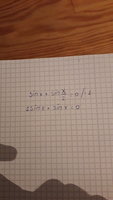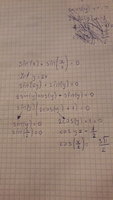You are using an out of date browser. It may not display this or other websites correctly.
You should upgrade or use an alternative browser.
You should upgrade or use an alternative browser.
A trigonometric equation
- Thread starter Albi
- Start date
lev888
Elite Member
- Joined
- Jan 16, 2018
- Messages
- 2,995
Is it (sinx)/2 or sin(x/2)?View attachment 18712What should I do next?
What you did would work for (sinx)/2, but not for sin(x/2).
Why not is the same thingIs it (sinx)/2 or sin(x/2)?
What you did would work for (sinx)/2, but not for sin(x/2).
lev888
Elite Member
- Joined
- Jan 16, 2018
- Messages
- 2,995
It works with multiplication and division, but not with functions.Why not is the same thing
E.g. (ab)/2 = a(b/2).
But sin(180°)/2 = 0 and sin(180°/2) = 1.
You need to review this before working on trig equations.
What should I do then?It works with multiplication and division, but not with functions.
E.g. (ab)/2 = a(b/2).
But sin(180°)/2 = 0 and sin(180°/2) = 1.
You need to review this before working on trig equations.
lev888
Elite Member
- Joined
- Jan 16, 2018
- Messages
- 2,995
I would look at double angle formulas. But I don't think you are ready, based on post #3.What should I do then?
Do you mean half angle formulas?I would look at double angle formulas. But I don't think you are ready, based on post #3.
pka
Elite Member
- Joined
- Jan 29, 2005
- Messages
- 11,974
The first you should do is learn to correctly learn function notation.What should I do then?
The sine is a function. So use function notation. We don't write fx for \(f(x)\) do we?
Thus we don't write \(\sin x\) for \(\sin(x)\).
So I should write it this way sin (x)+sin (x/2)=0The first you should do is learn to correctly learn function notation.
The sine is a function. So use function notation. We don't write fx for \(f(x)\) do we?
Thus we don't write \(\sin x\) for \(\sin(x)\).
pka
Elite Member
- Joined
- Jan 29, 2005
- Messages
- 11,974
Thank you, thank you. Yes indeed, I wish the rest of our community would be so accommodating.So I should write it this way sin (x)+sin (x/2)=0
As head of a division of mathematical sciences, I told any textbook committee not to bring me any recommendation on a text that use that notation: \(\sin x, \cos x, \tan x\) or use \(\ln(x)\text{ for }\log(x).\)
I accept that a function should be written in the form that you said but anyways let's get to the main point do you know what should I do to solve the equation?Thank you, thank you. Yes indeed, I wish the rest of our community would be so accommodating.
As head of a division of mathematical sciences, I told any textbook committee not to bring me any recommendation on a text that use that notation: \(\sin x, \cos x, \tan x\) or use \(\ln(x)\text{ for }\log(x).\)
lev888
Elite Member
- Joined
- Jan 16, 2018
- Messages
- 2,995
I suggested double angle formulas, did you look them up?I accept that a function should be written in the form that you said but anyways let's get to the main point do you know what should I do to solve the equation?
topsquark
Senior Member
- Joined
- Aug 27, 2012
- Messages
- 2,306
ln(x) is still preferred in Physics. So thhhhpppttt!Thank you, thank you. Yes indeed, I wish the rest of our community would be so accommodating.
As head of a division of mathematical sciences, I told any textbook committee not to bring me any recommendation on a text that use that notation: \(\sin x, \cos x, \tan x\) or use \(\ln(x)\text{ for }\log(x).\)
-Dan
lev888
Elite Member
- Joined
- Jan 16, 2018
- Messages
- 2,995
Do you see that in your problem one of the angles is double the other?Do you mean half angle formulas?
topsquark
Senior Member
- Joined
- Aug 27, 2012
- Messages
- 2,306
I'll add one more piece of detail:I suggested double angle formulas, did you look them up?
[math]sin(x) + sin \left ( \dfrac{x}{2} \right ) = 0[/math]
Let y = 2x. Then
[math]sin(2y) + sin(y) = 0[/math]
Now use the double angle formulas.
-Dan
If you know the unit circle you know that -1/2 can be written as 2pi/3.How did -1/2 become 3pi/2?
Also y is not 2x.
As for the second part I took y as 2x to help me to solve the equation easier you can see that in the end I replaced y with x/2.
Dr.Peterson
Elite Member
- Joined
- Nov 12, 2017
- Messages
- 16,604
If you know the unit circle you know that -1/2 can be written as 2pi/3.
As for the second part I took y as 2x to help me to solve the equation easier you can see that in the end I replaced y with x/2.
I think these were both mere typos! At the bottom of post #16 you corrected the 3 pi/2 to 2 pi/3, and while you wrote y = 2x, you clearly replaced x/2, not 2x, with y, and vice versa at the end. That is, you let x = 2y. But it is important to write what you mean.
Of course, what you meant here is not "-1/2 can be written as 2pi/3", but "the inverse cosine of -1/2 is 2pi/3 ".
If I would let 2y=x that would've made more sense.I think these were both mere typos! At the bottom of post #16 you corrected the 3 pi/2 to 2 pi/3, and while you wrote y = 2x, you clearly replaced x/2, not 2x, with y, and vice versa at the end. That is, you let x = 2y. But it is important to write what you mean.
Of course, what you meant here is not "-1/2 can be written as 2pi/3", but "the inverse cosine of -1/2 is 2pi/3 ".


